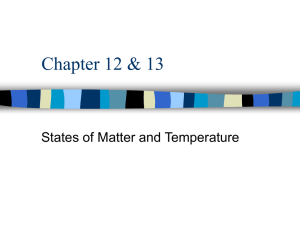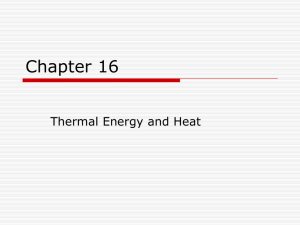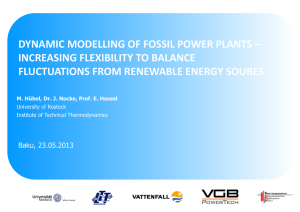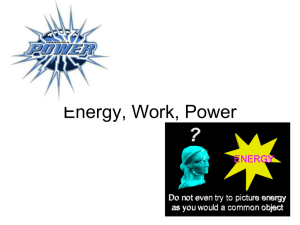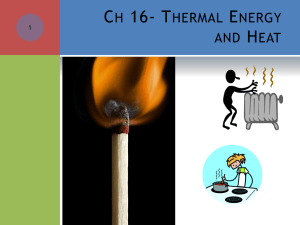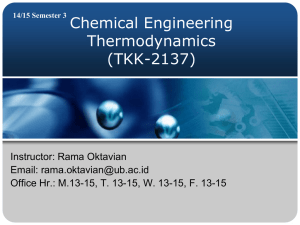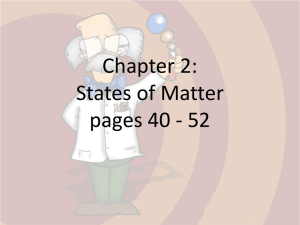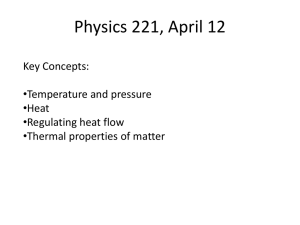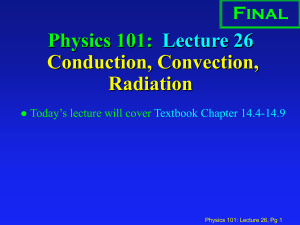16.2 Heat and Thermodynamics
advertisement
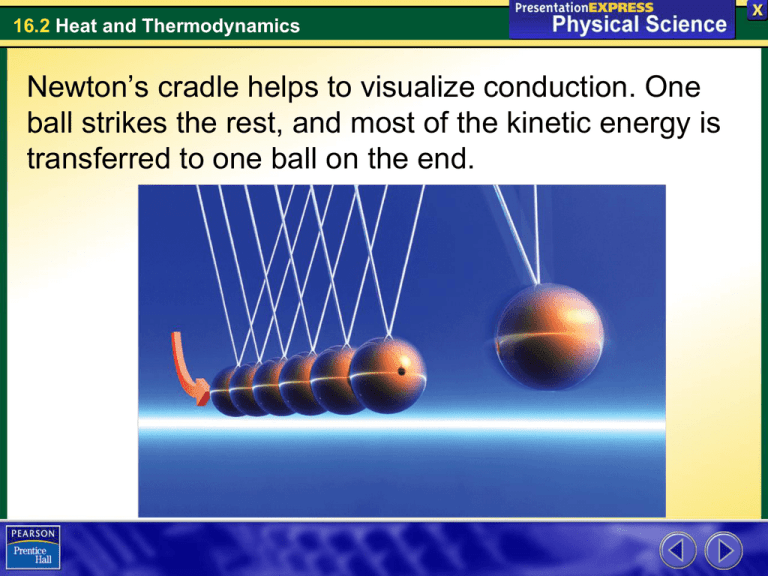
16.2 Heat and Thermodynamics Newton’s cradle helps to visualize conduction. One ball strikes the rest, and most of the kinetic energy is transferred to one ball on the end. 16.2 Heat and Thermodynamics II. Heat and Thermodynamics A. Conduction- the transfer of thermal energy with no overall transfer of matter. 1. Conduction occurs within a material or between materials that are touching. 2. In conduction, collisions between particles transfer thermal energy, without any overall transfer of matter. a. Conduction in gases is slower than in liquids and solids because the particles in a gas collide less often. 16.2 Heat and Thermodynamics 3. Thermal conductor -a material that conducts thermal energy well. a. Metals are good thermal conductors. 1) When a frying pan is on a hot stove, the bottom of the metal pan heats first and the metal handle last. The flames do not directly heat the handle. b. Tile is a better conductor than wood. 1) A tile floor feels colder than a wooden floor when both floors are at room temperature. 2) The tile transfers thermal energy more rapidly away from your skin. 16.2 Heat and Thermodynamics Conduction The arrows show how thermal energy is conducted away from the heat source in a metal frying pan. 16.2 Heat and Thermodynamics 4. Thermal insulator- material that conducts thermal energy poorly. a. Air is a very good insulator. Wool garments and plastic foam cups use trapped air to slow down conduction. 16.2 Heat and Thermodynamics B. Convection -the transfer of thermal energy when particles of a fluid move from one place to another. 1. A convection current occurs when a fluid circulates in a loop as it alternately heats up and cools down. a. Air at the bottom of an oven heats up, expands, and becomes less dense. The hot air rises. b. Rising hot air cools as it moves away from the heat source. c. As a result, the coolest air is at the top of the oven. 2. Convection currents are important in many natural cycles, such as ocean currents, weather systems, and movements of hot rock in Earth’s interior. 16.2 Heat and Thermodynamics Convection A. Passing sandbags along a line is like transferring thermal energy by convection. B. The arrows show convection of air in an oven. 16.2 Heat and Thermodynamics C. Radiation-the transfer of energy by waves moving through space. 1. All objects radiate energy. As an object’s temperature increases, the rate at which it radiates energy increases. a. When you stand to the side of a charcoal grill, heat reaches you without convection or conduction. b. The sun warms you by radiation on a clear day. The space between the sun and Earth has no air to transfer thermal energy. c. Heat lamps used in restaurants are another example of radiation. 16.2 Heat and Thermodynamics Radiation The heating coil on a stove radiates thermal energy. The changing color of the red arrows indicates that the farther you are from the coil, the less radiation you receive. 16.2 Heat and Thermodynamics D. Thermodynamics- The study of conversions between thermal energy and other forms of energy 1. The first law of thermodynamics states that energy is conserved. a. Energy cannot be created or destroyed, but it can be converted into different forms. b. Added energy increases the thermal energy of a system or does work on the system. In either case, energy is conserved. 16.2 Heat and Thermodynamics Thermodynamics James Prescott Joule (1818-1889) carefully measured the energy changes in a system. Joule's system included a falling weight that turned a paddle wheel in a container of water. Joule found that the work done by the falling weight almost exactly equaled the thermal energy gained by the water. 16.2 Heat and Thermodynamics Thermodynamics Pushing on the pump does work on the system. Some of the work is converted into thermal energy, which heats the air in the pump and the tire. 16.2 Heat and Thermodynamics 2. The second law of thermodynamics states that thermal energy can flow from colder objects to hotter objects only if work is done on the system. a. Thermal energy flows spontaneously only from hotter to colder objects. 1) A refrigerator must do work to transfer thermal energy from the cold food compartment to the warm room air. 2) The thermal energy is released by coils at the bottom or in the back of the refrigerator. 16.2 Heat and Thermodynamics b. Heat engine - any device that converts heat into work. 1) The efficiency of a heat engine is always less than 100 percent. 2) Thermal energy that is not converted into work is called waste heat. 3) Waste heat is lost to the surrounding environment. 16.2 Heat and Thermodynamics Thermodynamics Spontaneous changes will always make a system less orderly, unless work is done on the system. For example, if you walk long enough, your shoelaces will become untied. But the opposite won't happen; shoelaces don't tie themselves. Disorder in the universe as a whole is always increasing. 16.2 Heat and Thermodynamics Thermodynamics The efficiency of a heat engine increases with a greater difference between the high temperature inside and the cold temperature outside the engine. A heat engine could be 100 percent efficient if the cold outside environment were at absolute zero (0 Kelvin). This would violate the third law of thermodynamics. 16.2 Heat and Thermodynamics 3. The third law of thermodynamics states that absolute zero cannot be reached. 16.2 Heat and Thermodynamics Thermodynamics The third law of thermodynamics states that absolute zero cannot be reached. This physicist uses a laser to cool rubidium atoms to 3 billionths of a Kelvin above absolute zero. 16.2 Heat and Thermodynamics Assessment Questions 1. What form of energy transfer requires the motion of particles of a fluid? a. b. c. d. conduction convection radiation insulation 16.2 Heat and Thermodynamics Assessment Questions 1. What form of energy transfer requires the motion of particles of a fluid? a. b. c. d. conduction convection radiation insulation ANS: B 16.2 Heat and Thermodynamics Assessment Questions 2. What happens in every case in which energy is added to a system? a. b. c. d. Temperature increases. Work is done on the system. All of the energy can be accounted for as work or heat. An identical amount of energy is removed from the system. 16.2 Heat and Thermodynamics Assessment Questions 2. What happens in every case in which energy is added to a system? a. b. c. d. Temperature increases. Work is done on the system. All of the energy can be accounted for as work or heat. An identical amount of energy is removed from the system. ANS: C 16.2 Heat and Thermodynamics Assessment Questions 3. Thermal energy can move from a cooler object to a warmer object when a. b. c. d. the warmer object is larger. the cooler object has more thermal energy. energy is transferred by radiation. work is done on the system. 16.2 Heat and Thermodynamics Assessment Questions 3. Thermal energy can move from a cooler object to a warmer object when a. b. c. d. the warmer object is larger. the cooler object has more thermal energy. energy is transferred by radiation. work is done on the system. ANS: D 16.2 Heat and Thermodynamics Assessment Questions 4. According to the third law of thermodynamics, it is impossible a. to cool an object to absolute zero. b. transfer thermal energy from a cooler object to a warmer object. c. convert energy from one form to another. d. account for all of the energy in a system. 16.2 Heat and Thermodynamics Assessment Questions 4. According to the third law of thermodynamics, it is impossible a. to cool an object to absolute zero. b. transfer thermal energy from a cooler object to a warmer object. c. convert energy from one form to another. d. account for all of the energy in a system. ANS: A 16.2 Heat and Thermodynamics Assessment Questions 1. All metals are good thermal insulators. True False 16.2 Heat and Thermodynamics Assessment Questions 1. All metals are good thermal insulators. True False ANS: F, conductors
